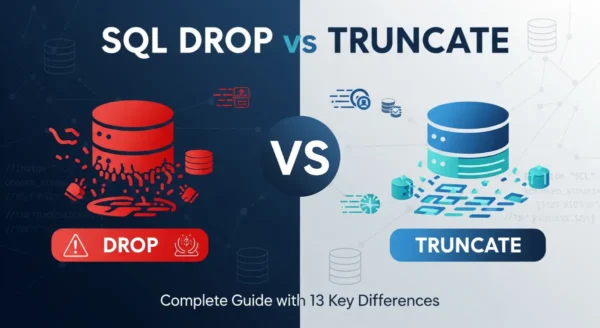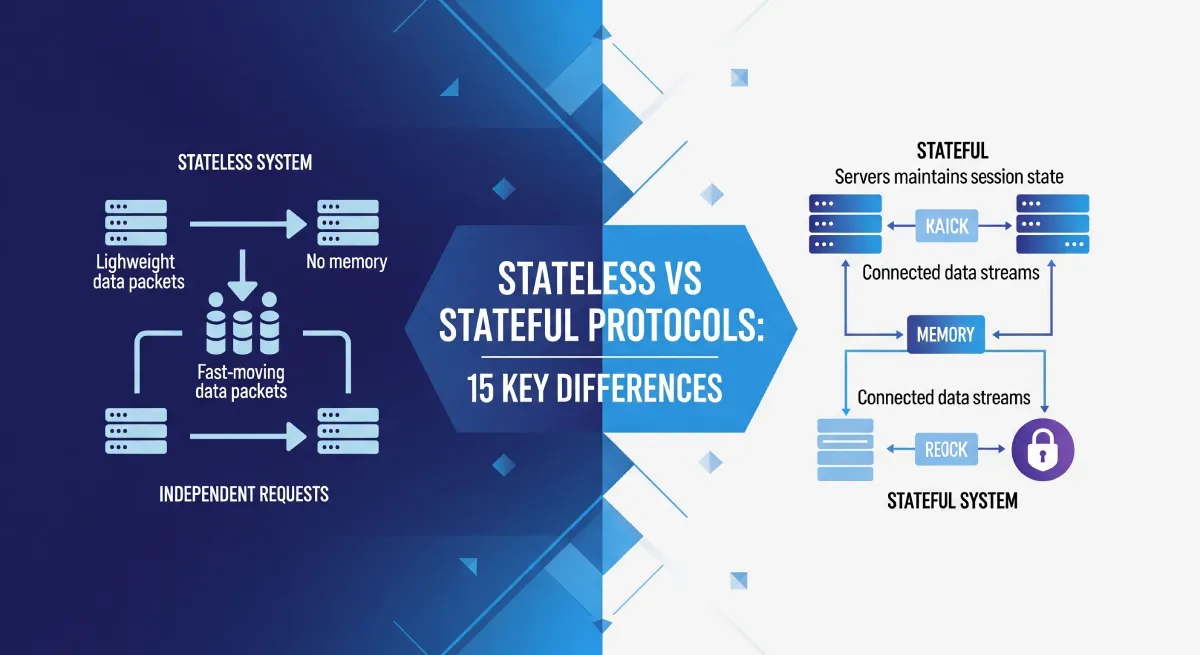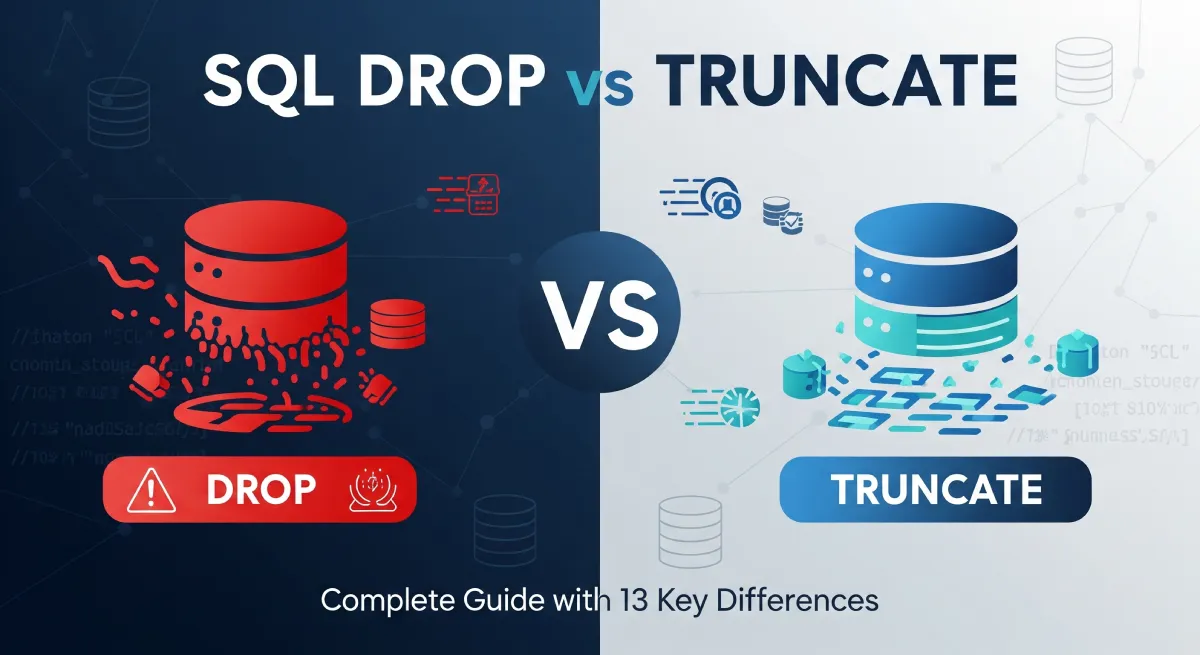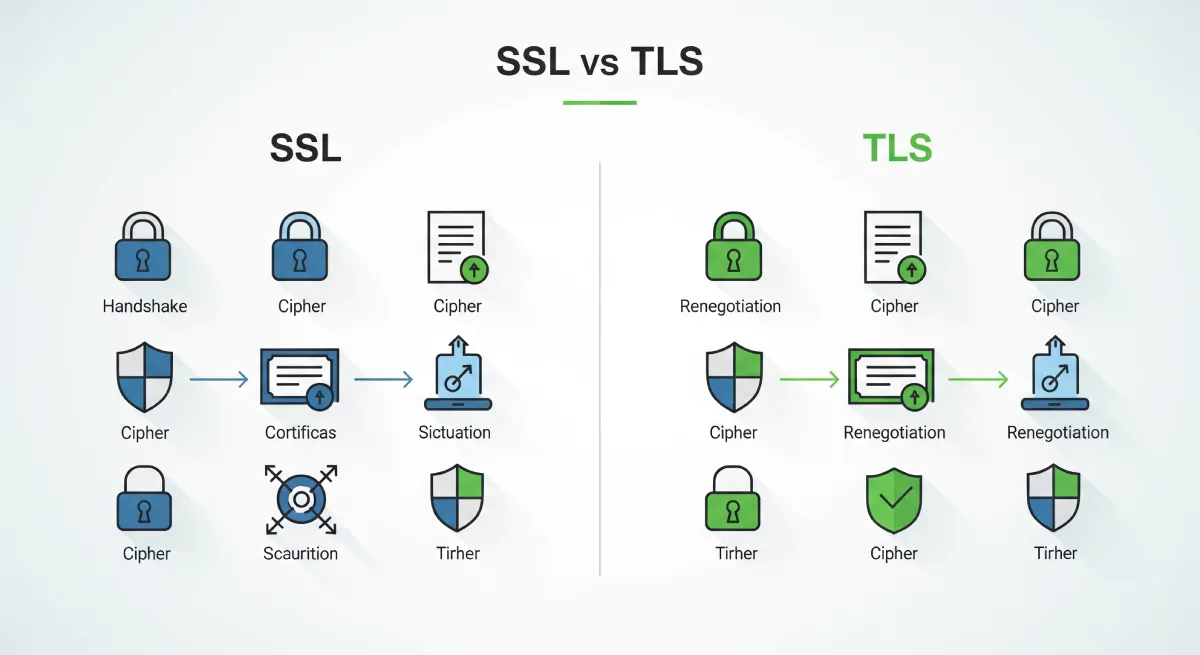- 1. Introduction to DROP vs TRUNCATE
- 2. Understanding the DROP Command
- 3. Understanding the TRUNCATE Command
- 4. 13 Key Differences Between DROP and TRUNCATE
- 5. Performance Analysis
- 6. When to Use Each Command
- 7. Practical Implementation Examples
- 8. Best Practices and Safety Tips
- 9. Common Mistakes to Avoid
- 10. Frequently Asked Questions
- 11. Conclusion
Introduction
Understanding when to use SQL DROP vs TRUNCATE is crucial for effective database management. While both commands remove data from tables, they function differently and have distinct impacts on database structure, performance, and recovery.
Whether you’re a database administrator, developer, or student learning SQL, knowing the right command to use can save you from data loss disasters and improve your database performance significantly.

Understanding the DROP Command
The DROP command is a Data Definition Language (DDL) statement that completely removes a table from the database. When you execute DROP, you’re not just deleting data – you’re removing the entire table structure, including all associated objects.
DROP Command Syntax
DROP TABLE table_name;DROP TABLE IF EXISTS table_name;What Gets Removed with DROP
- All table data and records
- Table structure and schema definition
- Indexes associated with the table
- Constraints (Primary keys, Foreign keys, Check constraints)
- Triggers defined on the table
- Permissions granted on the table
Advantages of DROP
- Complete removal: Eliminates the table and all associated database objects
- Storage recovery: Frees up all allocated storage space immediately
- Clean database: Removes all references and dependencies
Disadvantages of DROP
- Permanent data loss: No built-in recovery mechanism
- Recreation overhead: Requires rebuilding entire table structure if needed again
- Dependency issues: Can break applications or queries that reference the table
Understanding the TRUNCATE Command
The TRUNCATE command is a DDL statement that removes all rows from a table while preserving the table structure. Think of it as emptying a container while keeping the container itself intact.
TRUNCATE Command Syntax
TRUNCATE TABLE table_name;What Happens with TRUNCATE
- All data rows are removed
- Table structure remains intact
- Indexes are preserved but emptied
- Constraints remain in place
- Auto-increment counters are reset to initial values
- Storage space for data pages is deallocated
Advantages of TRUNCATE
- Speed: Much faster than DELETE for removing all records
- Structure preservation: Keeps table ready for immediate use
- Minimal logging: Uses less transaction log space
- Identity reset: Automatically resets auto-increment values
Disadvantages of TRUNCATE
- Foreign key limitations: Cannot be used on tables with foreign key references
- No conditional removal: Cannot specify WHERE conditions
- Trigger behavior: Does not fire DELETE triggers
- Limited rollback: Cannot be rolled back in some database systems
Performance Analysis: DROP vs TRUNCATE
DROP Performance
- Slower for large tables
- More system resource intensive
- Requires metadata updates
- May cause blocking in busy systems
TRUNCATE Performance
- Extremely fast operation
- Minimal resource consumption
- Less transaction log overhead
- Quick completion even on large tables
13 Key Differences Between SQL DROP vs TRUNCATE
Aspect | DROP | TRUNCATE |
|---|---|---|
| Primary Operation | Removes entire table structure and data | Removes only data, keeps table structure |
| Data Recovery | No recovery possible without backup | Structure remains for data re-insertion |
| Speed Performance | Slower, especially for large tables | Very fast, even with millions of records |
| Storage Space | Completely releases all allocated space | Releases data pages, keeps structure space |
| Transaction Logging | Logs metadata changes | Minimal logging (page deallocations only) |
| Foreign Key Constraints | Must handle dependencies first | Cannot execute if table is referenced |
| Identity Column Reset | N/A (column is removed) | Automatically resets to seed value |
| Trigger Execution | May fire DROP triggers | Does not fire DELETE triggers |
| Permissions Required | Requires DROP permission or ownership | Requires ALTER permission on table |
| Rollback Capability | Usually cannot be rolled back | Limited rollback support (DB dependent) |
| Index Handling | All indexes are permanently removed | Indexes remain but are emptied |
| Conditional Execution | Can use IF EXISTS clause | Cannot specify WHERE conditions |
| Common Use Case | Permanent table removal during cleanup | Quick data reset for testing/staging |
Choosing the Right Command
When to Use DROP
- Database cleanup: Removing obsolete or unused tables
- Schema restructuring: Major database redesigns
- Application retirement: Decommissioning old systems
- Storage optimization: Freeing up significant disk space
- Development cleanup: Removing test or prototype tables
- Migration scenarios: Moving to new table designs
When to Use TRUNCATE
- Data refresh: Loading fresh data from external sources
- Testing scenarios: Quickly resetting test data
- Staging environments: Preparing tables for new data loads
- Batch processing: Clearing tables before bulk operations
- Performance optimization: Faster than DELETE for complete removal
- Identity reset: When you need auto-increment to restart
Practical Implementation Examples
DROP Implementation Examples
Basic DROP Example
-- Remove a table completelyDROP TABLE employees;-- Safe DROP with existence checkDROP TABLE IF EXISTS temp_reports;-- DROP with cascade (removes dependent objects)DROP TABLE customers CASCADE;Pre-DROP Safety Checks
-- Check table dependencies before droppingSELECT TABLE_NAME, REFERENCED_TABLE_NAME FROM INFORMATION_SCHEMA.KEY_COLUMN_USAGE WHERE REFERENCED_TABLE_NAME = 'employees';-- Create backup before droppingCREATE TABLE employees_backup AS SELECT * FROM employees;DROP TABLE employees;TRUNCATE Implementation Examples
Basic TRUNCATE Example
-- Remove all data but keep table structureTRUNCATE TABLE order_items;-- TRUNCATE with transaction (if supported)BEGIN TRANSACTION;TRUNCATE TABLE temp_calculations;COMMIT;Handling Foreign Key Constraints
-- Disable constraints temporarilyALTER TABLE order_items DISABLE CONSTRAINT fk_order_id;TRUNCATE TABLE order_items;ALTER TABLE order_items ENABLE CONSTRAINT fk_order_id;-- Alternative: Use DELETE insteadDELETE FROM order_items;Step-by-Step Decision Process
- Assess your goal: Do you need the table structure later?
- Check dependencies: Are there foreign key references?
- Consider data volume: How much data are you removing?
- Evaluate recovery needs: Might you need to restore data?
- Review permissions: Do you have the required access rights?
- Plan for safety: Create backups if necessary
- Execute the appropriate command
Best Practices and Safety Tips
Golden Rules for Database Operations
Always prioritize data safety and system stability when performing destructive operations.
Pre-Execution Safety Checklist
For DROP Operations
- Verify table dependencies
- Create full database backup
- Document the DROP reason
- Test on non-production first
- Inform team members
- Schedule during maintenance window
For TRUNCATE Operations
- Check foreign key constraints
- Backup critical data if needed
- Verify triggers won’t be needed
- Confirm identity reset is acceptable
- Test with small dataset first
- Consider transaction boundaries
Performance Optimization Tips
- Timing: Execute during low-traffic periods
- Monitoring: Watch system resources during execution
- Batch operations: For multiple tables, plan the sequence
- Index considerations: Rebuild indexes after large operations if needed
- Statistics update: Refresh table statistics post-operation
Recovery Planning
Before Executing Destructive Operations
-- Create point-in-time backupBACKUP DATABASE YourDB TO DISK = 'C:\Backup\YourDB_BeforeDrop.bak';-- Export specific table dataSELECT * INTO employees_backup_20250719 FROM employees;-- Script out table structure-- Use SSMS "Generate Scripts" wizard or equivalentCommon Mistakes to Avoid
Critical Mistakes and How to Avoid Them
Mistake #1: Wrong Command Selection
Problem: Using DROP when you meant TRUNCATE, losing table structure unnecessarily.
Solution: Always double-check your intention before execution. Create a mental checklist.
Mistake #2: Ignoring Foreign Key Constraints
Problem: Attempting TRUNCATE on tables with foreign key references.
Solution: Check constraints first or use DELETE with WHERE clause.
Mistake #3: No Backup Strategy
Problem: Executing commands without backup, making recovery impossible.
Solution: Always backup critical data before destructive operations.
Mistake #4: Production Environment Testing
Problem: Testing DROP/TRUNCATE commands directly on production systems.
Solution: Always test on development or staging environments first.
Emergency Recovery Procedures
If You’ve Made a Mistake:
- Stop immediately – Don’t execute more commands
- Assess the damage – What exactly was affected?
- Check backups – Identify the most recent valid backup
- Plan recovery – Determine the best restoration approach
- Execute recovery – Restore from backup methodically
- Verify results – Ensure data integrity after recovery
- Document incident – Learn from the experience
Frequently Asked Questions
Conclusion
Understanding the differences in SQL DROP vs TRUNCATE commands is essential for effective database management. Each serves a distinct purpose and carries unique implications for your data integrity and database performance.
Use DROP When:
- You need complete table removal
- Database cleanup is required
- Schema restructuring is planned
- Storage space recovery is critical
Use TRUNCATE When:
- You need to keep table structure
- Fast data removal is priority
- Identity columns need resetting
- Minimal logging is desired
Key Decision Criteria
When choosing between SQL DROP vs TRUNCATE commands, consider these essential factors.
- Data Retention Needs: If you need to preserve table structure for future use, choose TRUNCATE. For complete removal, use DROP.
- Performance Requirements: TRUNCATE offers superior performance for large datasets and consumes fewer system resources.
- Dependency Management: Evaluate the impact on foreign key constraints, triggers, and dependent applications before execution.
- Recovery Planning: Consider your backup strategy and recovery requirements before proceeding with either command.
- System Impact: TRUNCATE has minimal impact on system resources, while DROP may affect dependent database objects.
Final Recommendations
For most routine data management tasks, TRUNCATE is the preferred choice when you need to empty tables quickly while preserving their structure. Reserve DROP for scenarios where you’re certain about permanent table removal and have addressed all dependencies.
Remember that both commands are powerful tools that can cause irreversible data loss. Always implement proper backup strategies, test in non-production environments, and follow established change management procedures in your organization.
By applying the knowledge from this comprehensive guide, you’ll be able to make informed decisions about when to use SQL DROP vs TRUNCATE, optimize your database operations, and maintain data integrity while achieving your performance goals.



